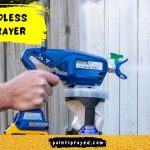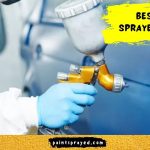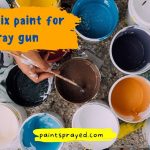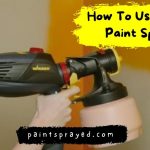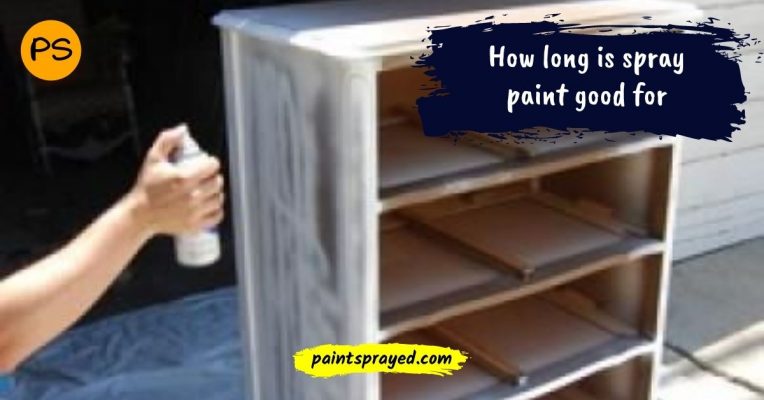Are you looking for a high-quality car paint job to give your automotive a fresh new look?
Picking a professional, local shop to paint your car is generally the most preferred choice as it is much more cost-effective than doing the job yourself.
In this case, an auto spray gun can be your best friend forever and even save you money!
Now the good thing about having an automotive air sprayer on hand is that you may not know what specific things go into doing the job well.
You don’t have to struggle anymore because we’re here to share with you our best insights.
Today I will guide you guys on how to paint a car with a paint gun. This post is for those guys who are new in this field and are confused about painting on a car.
How to paint a car with a paint gun?
Things required to paint a car
Here is the list of those tools which you will be needing in order to paint a car.
- There should be a proper paint booth for this process
- Compressor
- Topcoat paint
- Cable extension cord
- Step stool to reach the floor of the car
- Sweeping brush to clean the paint
- Buffing pad to buff the surface
- Paint pourer to pour the paint in the sprayer
- Water and mop to clean the paint residue from the floor
- Paint filters for sprayer
- Vacuum to suck the paint and other stuff
- Poly sheeting
- A masking tape will be used for covering the surface
- Protective gear
Setting the space for the project
Of course, your spraying area will be set up with some preparation already. Hopefully, you used an HVLP gun to spray primer on the car, which means it’s clean enough for this next stage.
Still, you may want to finish a few things off now that we’re about to move forward with the paint. You can learn how to spray paint car rims from my blog.
If you’re going to be restoring your classic car then having the correct gear on hand will make a huge difference in how easy it all is.
Even though prepping some areas can be messy and dusty, put on your protective wear including goggles, mask, overalls, and gloves!
This might sound funny when you are preparing to paint your motor vehicle but never attempt to paint your classic car outside unless you want your three-tone pearl to be adorned with dusty.
Stuck leaves, grit, and slowly dying insects. Instead choose an indoor area such as a garage, 4-sided garden pavilion, or inflatable spraying booth.
It is highly important to ensure you have a space without any oil or dirt in it.
Setting up the painting area should be handled with the same care that serial killer uses when ensuring they get rid of all of the evidence in their garage.
It is imperative that your garage has a clean floor and walls because there will be paint flying everywhere.
There is a very high chance that some of this paint will land on you, so please put on clothing that you can throw out afterward.
As well as eye protection and ear plugs/earmuffs, gloves, a hairnet, and an appropriate facemask like those used at hospitals, building sites, etc.
If you’re particularly a neat freak — or you want to paint at pro-level — cover all walls with polythene sheeting adhered with masking tape.
Not only will this prevent missed dirt from attaching itself to your fresh coat of paint, but it can also shield your garage area from paint splatters.
Setting up the equipment
Most times all you need to do is prep your equipment – usually, this just means shearing off any access packing and cleaning/prep for each paint gun as necessary.
Reference my guide below on how to set up a compressor gun if applicable.
You should set the equipment up whenever you want to paint the car from the outside or if you want to paint interior of car. Always set up the equipment so you can easily do the paint job.
There’s also no need for paint thinning when coating in most instances, it’s actually discouraged with automotive paints.
Setting up a spray gun for use can be quite difficult for beginners. To set up your spray gun, you must first pour the paint into a paint cup.
Make sure you measure out the ideal amount to get a perfect finish. Once you do that, attach your canister using a lid on top.
Now turn on the compressor and wait until there’s enough pressure in it because setting up the equipment might take some time depending on how often you use it.
Then select a narrow tip for fine atomization (1.3 mm or below), and set your LVLP gun to the lowest pressure setting; both on the gun handle and inline regulator.
Using various techniques of applying paint with different settings allows one to create various designs while spending less time doing so.
Process of spraying the car
You know, spraying the car can be pretty tricky. But if you want to do it right you should master some practical skills for yourself so that you can see the results with your own eyes.
The first thing is to make sure that you are using the right grade of paint and always apply a primer as a base coat.
(Unless before the priming stage, you removed body panels and doors – in which case the order of painting doesn’t matter).
So, what we recommend is to apply one thin layer of primer and wait 15 minutes, then apply one thin layer of paint and wait 30 minutes.
Then repeat these steps until your whole car has been covered in an even coat.
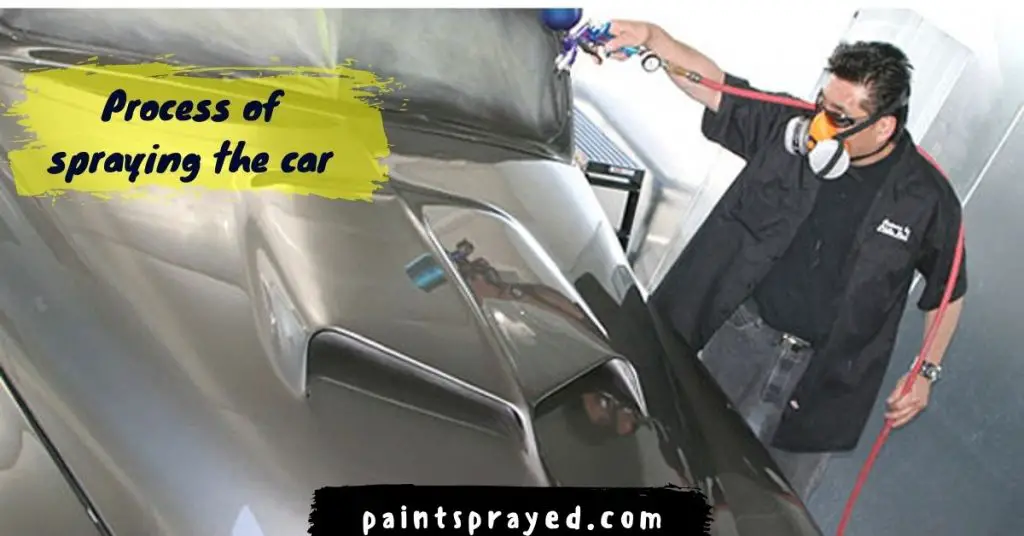
Also, make sure that whatever area you are working on is completely finished before returning to another part of your car.
But don’t leave wet paint once it begins to dry because it will leave your vehicle looking patchy.
And now comes the step where the step stool will be used.
For painting these surfaces mentioned below the stool will be helpful for you guys:
- Roof
- Hood
- Trunk
- Front side panels
- Doors
- Rear side panels
- Exposed interior areas
Spraying your car can be a lot of fun, but you have to make sure that you’re doing it the right way so as not to get sloppy results.
It takes a steady hand and a lot of patience in order to apply just the right amount of paint.
To avoid getting an undesirable result, always make sure your gun is parallel to the canvas you’re painting and at a consistent distance away.
If any areas need precise, dirty work like nooks or tiny crevices — shorten the nozzle on your gun, which will then spray out in a circular pattern in order to get into those hard-to-get spaces.
Can you use a spray gun to paint a car?
Yes, a spray gun can be used to paint a car.
Spray guns can provide a more even and consistent coat of paint than a brush or roller, and they can also save time and reduce the amount of overspray.
However, using a spray gun to paint a car requires some skill and experience.
And it is generally recommended for those with some level of experience in painting cars or other objects.
Additionally, a spray gun must be properly maintained and cleaned after use to avoid clogs and other issues.
What do you need to paint a car with a spray gun?
To paint a car with a spray gun, you will need the following:
- A spray gun: There are different types of spray guns available, such as HVLP (high volume, low pressure) and LVLP (low volume, low pressure) spray guns. HVLP guns are generally considered to be better for beginners and are more efficient, while LVLP guns are more powerful and produce a finer finish.
- Compressor: A compressor is required to power the spray gun. The size of the compressor will depend on the type of spray gun you are using, but it should be able to provide at least 5-7 CFM (cubic feet per minute) at 90 PSI (pounds per square inch)
- Paint: You will need paint specifically made for the type of car you are painting and the type of paint gun you are using.
- Masking tape and paper: This will be used to cover and protect the parts of the car that you do not want to paint.
- Sandpaper and primer: The car will need to be sanded and primed before painting to ensure a smooth finish
- Cleaning supplies: You will need to clean the spray gun and other equipment after use to avoid clogs and other issues.
- Personal Protective Equipment (PPE): This includes a respirator mask, goggles, and gloves to protect you from paint fumes and debris.
It is important to note that painting a car with a spray gun is a big project that requires a lot of preparation and practice.
If you are new to painting cars or using a spray gun, it is recommended to seek guidance from professionals or take a training course before attempting to paint your car.
What air pressure for painting a car?
The air pressure required for painting a car with a spray gun will vary depending on the type of spray gun you are using and the type of paint you are applying.
For HVLP (high volume, low pressure) spray guns, the recommended air pressure is between 10-15 PSI (pounds per square inch).
For LVLP (low volume, low pressure) spray guns, the recommended air pressure is between 4-8 PSI.
It is important to refer to the manufacturer’s instructions for the specific air pressure recommendations for the spray gun you are using.
It’s also important to note that the air pressure should be adjusted according to the type of paint you are using, as some types of paint may require higher or lower pressure.
It is also important to note that the air pressure is not the only factor in the quality of the finish.
The distance of the gun from the surface, the speed of the gun movement, and the amount of paint that is being used are also important factors to achieve a good finish.
Do you add water to paint when using a spray gun?
It depends on the type of paint and the spray gun that you are using. Some types of paint, such as latex paint, can be thinned with water to make them more suitable for use in a spray gun.
However, not all types of paint can be thinned with water, and some should not be thinned at all.
If you are using an HVLP (high volume, low pressure) spray gun, it is generally recommended to thin latex paint with water to a viscosity suitable for the spray gun.
The recommended ratio for thinning latex paint with water is usually about 10-15% water to paint by volume.
If you are using an LVLP (low volume, low pressure) spray gun, the paint usually comes ready to use and does not require thinning.
It’s important to always refer to the paint and spray gun manufacturer’s instructions for guidance on thinning the paint and the appropriate ratio to use.
Additionally, it’s important to note that when using a spray gun, it’s best to use a paint strainer to filter the paint before spraying, this will remove any debris that may clog the nozzle.
Do you need to use auto paint cleaner before wax?
Yes, it’s recommended to use auto paint cleaner before waxing your car.
Auto paint cleaner is designed to remove contaminants and residue from the surface of the paint, such as dirt, grease, and old wax, which can interfere with the adhesion of the new wax and reduce its effectiveness.
Using auto paint cleaner before waxing can help ensure that the wax adheres properly and lasts longer, providing better protection for your car’s paint.
Auto paint cleaner can also help to restore the shine and luster of the paint, making it look like new again.
To use auto paint cleaner, you should first wash your car thoroughly to remove any loose dirt or debris.
Then, apply the auto paint cleaner with a soft sponge or applicator, working in small sections at a time.
Follow the instructions on the product carefully, and make sure to rinse the surface thoroughly with water after use.
Once the surface is dry, you can apply wax as usual, following the instructions on the wax product.
By using an auto paint cleaner before waxing, you can help ensure that your car’s paint stays in top condition for longer.
Can you use brake cleaner to prep metal before painting?
Brake cleaner is a very powerful solvent that is designed to remove brake dust, dirt, and other contaminants from brake components.
While it can be effective at removing oils and greases from metal surfaces, it’s not recommended to use it as a primary method for preparing metal surfaces before painting.
Brake cleaners can leave behind a residue that may interfere with the adhesion of the paint, and it can also be harmful to some types of paint, such as acrylics or lacquers.
Additionally, the chemicals in brake cleaners can be hazardous and should be used with caution, especially in poorly ventilated areas.
To prepare metal surfaces for painting, it’s best to use a dedicated metal prep solution or primer designed for that purpose.
These products are specifically formulated to clean and etch the surface, ensuring good adhesion for the paint.
Make sure to follow the instructions carefully and use the recommended safety equipment.
Can I use brake cleaner before painting?
While brake cleaner can be effective for removing grease and oil from metal surfaces, it is generally not recommended for use on walls before painting.
Brake cleaner is a strong solvent that is designed to remove brake dust, oil, and other contaminants from metal surfaces.
However, it can be harsh and abrasive, and may damage the surface of your walls or even strip off existing paint.
Furthermore, brake cleaner contains chemicals that may be harmful to your health if inhaled, so it is not a good idea to use it in an enclosed space like your home.
If you need to remove grease or oil from your walls before painting, there are other cleaning solutions that are safer and more effective.
A mild cleaning solution made from warm water and dish soap can be effective for most types of dirt and grime, while a solution of warm water and vinegar can be useful for tougher stains.
Always be sure to test any cleaning solution on a small, inconspicuous area of the wall first to ensure that it doesn’t damage the paint or finish.
And if you’re not sure which cleaner to use, consult with a professional painter for advice.
Can I use brake cleaner to clean metal before painting?
Yes, brake cleaner can be used to clean metal surfaces before painting.
Brake cleaner is a powerful solvent that is specifically designed to remove oil, grease, dirt, and other contaminants from metal surfaces.
It is commonly used in automotive applications to clean brake parts, engine components, and other metal surfaces before painting or assembly.
When using brake cleaner to clean metal surfaces before painting, it’s important to follow the manufacturer’s instructions carefully.
Shake the can well before use, and hold it about 6 to 8 inches away from the surface to be cleaned.
Spray the cleaner in short bursts, and wipe the surface clean with a clean, lint-free cloth.
Be sure to wear gloves and eye protection when working with brake cleaner, and use it in a well-ventilated area to avoid inhaling fumes.
Once the metal surface has been cleaned with brake cleaner, it’s important to let it dry completely before painting.
Any remaining solvent on the surface can interfere with the adhesion of the paint, leading to poor coverage or flaking.
To ensure that the surface is completely dry, allow it to air-dry for several hours, or use a clean, dry cloth to wipe away any excess cleaner before painting.
With proper preparation and care, your metal surface can be clean and ready for a smooth and even paint job.
FAQ’s of How to paint a car with a paint gun
Summary of How to paint a car with a paint gun
Here it is guys all the guides from my own experience. Hope this post helps you in painting your car. Professionals should comment and give tips if they have from their experience. Comment down here and let us know if this post helped you.
So, there you have it, our step-by-step guide to achieving the perfect paint job. Of course, the best way to get better at anything is to put the advice you’ve read into practice.
Practice makes perfect, remember that. So, if you’re not convinced your first time out, don’t get discouraged! It’s always a good idea to go over your work in progress with a buddy or two. Maybe even ask them to give you a few pointers. This is a great way to get honest, real-world feedback that will help you improve your skills.

Matthew Edward is a professional painter who loves to paint and wants to share useful tips and tricks which he had learned in many years of experience in painting. He also used many products that can be used for painting he has tried and tested each and every product to give an unbias opinion about it in his review. This blog is very useful for those newbies who want to learn painting without making mistakes.

